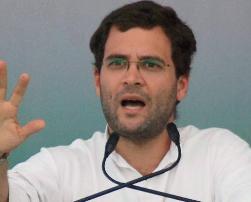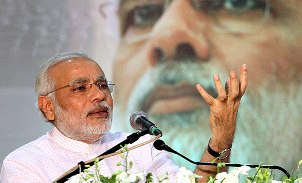  Rahul Gandhi’s accusation to unsuspecting Jhunjhunwallas in Rajasthan, that the opposition, Bharatiya Janata Party (BJP) had done a cut and paste job of the Congress manifesto, prompted Vineeta Shetty to take a closer look at the election promises enshrined in the manifestos of the two major parties.
The number of mobile subscribers crossed 95 crore, says the Congress in its UPA Report Card. Ten years ago, it was a mere 3.36 crore subscribers. Telephone density in rural areas has increased 26 times.
This bears examination. The 95 crore may well be an inflated figure and 50 crore may be closer to the truth, if visitor location registers are scrutinised, because of multiple SIMs owned by individuals. This minor point aside, subscriber growth and tele-density has grown in India because of heavy competition between service providers and their race for survival and mobile penetration. The UPA government has almost nothing to do with this, nor has it done too much to spread phone coverage, sitting as it does on the biggest pile of underutilized universal funds in the world.
If anything, the Congress-led coalition has distinguished itself by fostering a succession of telecommunication ministerswho have treated telecommunication resources as their private fiefdoms. The BJP, under Atal Behari Vajpayee, on the other hand, will be remembered for converting the licensing regime from a fixed-fee license to a revenue-shared one, which proved to be a turning point in Indian telecommunications by creating incentives for growth in the sector.
Much of the current unhygeine in the market has come from making operators pay through their noses for licenses. Service tax, ad valorem charges, spectrum charges and auction proceeds make India one of the highest tax-paying countries in the telecommunications world. The direct outcome of that, as industry leaders have been warning, is quantity at the expense of quality.
Capital outlay that could be going towards better infrastructure, sustainable energy and innovative services is being spent in public affairs, legal battles and brand management. Adding to the wastage that has characterized the UPA’s governance of telecommunications is the steep rise in the import of hardware, despite the many fine plans to step up local manufacture of infrastructure. Network equipment is said to be the country’s largest forex gobbler, after fuel and fertilisers.
Never before have mobile operators tread such a confrontational path with the government, as in recent years on any number of issues, including the price of spectrum. The cost of survival is expected to trigger mergers and business failures. That means the next government may well inherit an oligopoly of telecommunication operators.

Congress’ Manifesto:
Legacy aside, my curiosity was piqued by the Congress promise that it will give a renewed thrust to use of ICTs. In agriculture, financial services, commerce, education and health, the democratization of information is revolutionizing service delivery, citizen interface and accountability through innovative practices, the Congress manifesto recognizes in characteristically meandering fashion, heralding efforts to use ICTs to herald “transparency, efficiency, accountability and accessibility to create more inclusive and responsive structures that are in tune with the needs of the 21st century.”
Aadhar, the biometric 12-digit online identity for every Indian, has been in the eye of controversy over potential political misuse of citizen data. Narendra Modi, the BJP’s nominee for Prime Minister, may well criticize the programme on Nandan Nilekani’s home turf, but RTI activists have discovered that Gujarat State has implemented it with more than the usual efficacy, demanding details such as PAN Card numbers, election identity card details, ration and disability details on pain of penal action.
Privacy implications aside, Aadhar stands out as a singular achievement of the Congress. That is more than could be said for the Aapka Paisa Aapke Haath platform for all government programmes. The Congress believes that direct benefit transfer into people’s bank accounts will ensure time-bound delivery of benefits at the individual’s doorstep and remove corruption and leakages. But critics have criticized the subsidies on the same grounds as the National Rural Employment Guarantee scheme: it throws subsidies at citizens, providing no incentives for them to earnor improve their livelihood.
Investment in science and technology will be increased to at least 2% of GDP, says the manifesto, qualifying that this has to come from both government and industry. Equally, special tax incentives will be given for setting up manufacturing for popular-branded hardware in the IT sector. While this is heartening, such sops are already too little too late for the telecommunication sector, though there is a chance of catching the new wave of mobile to mobile technologies, if the ship of state is navigated well.
The Congress promises to connect all 2.5 lakh gram panchayats with high-speed broadband connectivity within 18 months, with a view to improve public delivery mechanism. In tandem, Congress intends to ensure the passage of the Electronic Delivery of Service Bill 2011, and to effectively deliver all public services such as passports, ration cards and driving licenses electronically. Here, at last, is a claim that is not too far-fetched. The vision to transform governance and service delivery made major strides in this regime. There has been a telling transformation in putting a vast number of citizen services, such as tax remittances and utility billing, on line. The connectivity to village administrations is also is a programme that has hit its strides, although again, it is the BJP-controlled Gujarat state that was the first in the country to implement statewide-area networking and capillarity of rural connections.
Among the more dubious of Congress’ claims is the implementation of the “India Inclusive Innovation Fund “so that innovative enterprises can profitably, scalably and competitively engage citizens at the bottom of the economic pyramid.
While the idea of a grassroots innovation fund is seductive, to date, despite an all-star cast at the National Innovation Council, the government has not been able to foster an innovation ecosystem to produce a single memorable app.

BJP’s Manifesto:
Turning to BJP’s manifesto, for design and layout at least, the challenger gets high marks. With effective governance and development as its mantra, BJP has placed E-Governance at the heart of reform: crisply articulatingtheuniversally-endorseddream of deployment of broadband in every village.
Traditional media were not enough for Mr. Modi to be kept abreast of the 2002 anti-Muslim riots in his own state, yet the BJP appears to make a fresh commitment to engage the citizenry through social media for participative governance.
In a refreshing change from Congress-style subsidies, the BJP promises IT-based jobs in rur |